

eSchool News I made my classroom look like the real-world—and test scores soared. Going Gradeless: Student Self-Assessment in PBL. I like reading professional material.
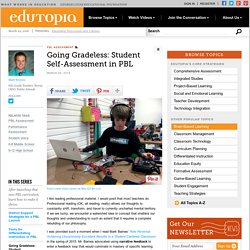
I would posit that most teachers do. Professional reading (OK, all reading, really) allows our thoughts to constantly shift, transform, and travel to currently uncharted mental territory. If we are lucky, we encounter a watershed idea or concept that shatters our thoughts and understanding to such an extent that it requires a complete rebuilding of our philosophy.
I was provided such a moment when I read Mark Barnes’ Role Reversal: Achieving Uncommonly Excellent Results in a Student-Centered Classroom in the spring of 2015. Mr. My Goal It was my intention to simultaneously promote mastery learning as well as increase students' ability to metacognitively assess their work against a given set of standards. Remove grades from the daily equation. My Plan I knew that I needed to maintain accountability to various stakeholders in this process -- the students, their families, and the administration. The Results. Edutopia. 5 Keys to Rigorous Project-Based Learning. Voiceover: How will today’s children function in a dangerous world?
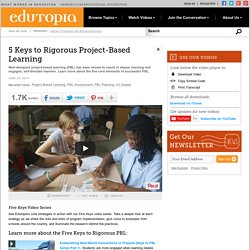
What means will they use to carve the future? Will they be equipped to find the answers to tomorrow’s problems? Teacher: When you think about traditional learning you think of a student sitting in a classroom and being talked at. Teacher: Now I imagine a lot of you are still thinking... Teacher: They are supposed to be a sponge. Peggy Ertmer: So there are a lot of different ways to approach PBL, a lot of different ways to implement it, but really it all boils down to five essential keys: real-world connection, core to learning, structured collaboration, student driven, and multifaceted assessment. Student: One of the problems in the ocean is that with the higher amount of CO2 calcifying organisms are decreasing and we’re testing to see how well life in the ocean lives without calcifying organisms. Student: --four by eight feet. Peggy Ertmer: So the second commonality is the PBL unit provides academic rigor. Student: Yes. These students are using PBL to define their own learning.
By Ashleigh Schultz April 21st, 2015 Project-based learning enhances and accelerates curriculum in this classroom If you’re doing it right, most project-based learning will hit every area of the curriculum, whether it’s social studies, math, reading, or even technology.
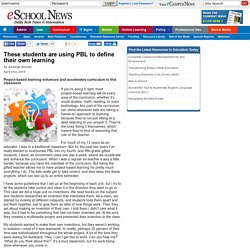
Untitled. Now it is possible for teachers to be in two, three or even six places at once.

Increase confidence in real-time assessments, maximize quality teacher time with students, and foster effective student collaboration and sharing. Learn More. These students are using PBL to define their own learning. What Is Design Thinking? WHAT IS DESIGN THINKING?
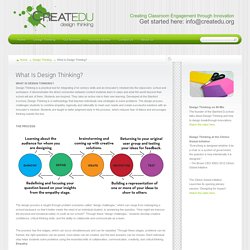
Design Thinking is a practical tool for integrating 21st century skills and an innovator’s mindset into the classroom, school and workplace. It demonstrates the direct connection between content students learn in class and what the world beyond their school will ask of them. Students are inspired. They take an active role in their own learning. Developed at the Stanford d.school, Design Thinking is a methodology that teaches individuals new strategies to solve problems.
What Is Design Thinking? Welcome to the Virtual Crash Course in Design Thinking. Welcome to the d.school’s Virtual Crash Course resource page!
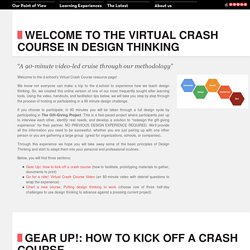
We know not everyone can make a trip to the d.school to experience how we teach design thinking. So, we created this online version of one of our most frequently sought after learning tools. Using the video, handouts, and facilitation tips below, we will take you step by step through the process of hosting or participating in a 90 minute design challenge. If you choose to participate, in 90 minutes you will be taken through a full design cycle by participating in The Gift-Giving Project. This is a fast-paced project where participants pair up to interview each other, identify real needs, and develop a solution to “redesign the gift-giving experience” for their partner.
Through this experience we hope you will take away some of the basic principles of Design Thinking and start to adapt them into your personal and professional routines. Below, you will find three sections: Gear Up! When students become entrepreneurs, real learning happens. By Jason Braddock April 16th, 2015 Some students get engaged with cross-curricular, large-scale project-based learning Here in eastern Ohio, some of our students are embracing their entrepreneurial spirit right at school, engaging in a style of learning that helps make lessons come alive.
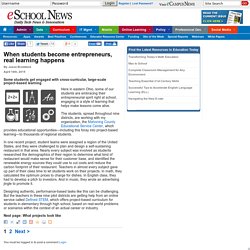
The students, spread throughout nine districts, are working with my organization, the Mahoning County Educational Service Center, which provides educational opportunities—including this foray into project-based learning—to thousands of regional students. In one recent project, student teams were assigned a region of the United States, and they were challenged to plan and design a self-sustaining restaurant in that area. Designing authentic, performance-based tasks like this can be challenging. 5 steps to a problem-solving classroom culture. Math problems can be engaging and thought-provoking with the right instructional strategies Problem solving is one of today’s top skills—students who apply problem-solving strategies in the classroom are building important talents for college and the workforce.
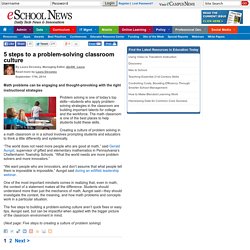
The math classroom is one of the best places to help students build these skills. Creating a culture of problem solving in a math classroom or in a school involves prompting students and educators to think a little differently and systemically. “The world does not need more people who are good at math,” said Gerald Aungst, supervisor of gifted and elementary mathematics in Pennsylvania’s Cheltenhamn Township Schools.
Project-based learning moves into classrooms. Project-based learning is gaining support in education circles Students at The Ellis School use the Hummingbird Robotics Kit to explore STEM.
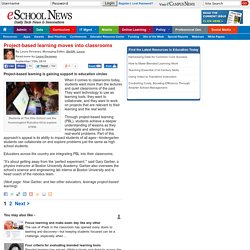
When it comes to classrooms today, students want more than the lectures and quiet classrooms of the past. Project-based learning done right. Parkside Elementary school’s “The Compass” program uses project-based learning to get students interested in their education Two years ago, Kyle was a bored kindergartener at Parkside Elementary school in Coral Springs, Fla.
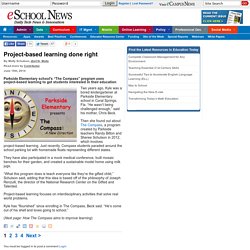
“He wasn’t being challenged enough,” said his mother, Chris Beck. Problem solving skills: The value added by maker spaces. What do great problem solvers do? They take time to carefully define a problem… Ineffective problem solvers sometimes go off track because they make assumptions about what a problem requires. An effective problem solver will take the time to ensure that she understands the problem and what it is asking. They know what they know… Good problem solvers perform an inventory of what they already know and incorporate that knowledge into their understanding of the problem and in their solution design. Unfamiliar Landscapes. Unfamiliar Landscapes We are surrounded by the landscapes of the natural world, the built environment, and even our bodies.
These landscapes shape not only what we see, but also how we experience the world, ourselves and each other. In this project and exhibition, we used the key concept of “unfamiliar landscapes” to learn how we create or alter landscapes, and how, in turn, landscapes alter us as individuals and community members. Day One-Looking at Student Work - DL2015Materials. Toy Story 2014. 3 Ways To Use Vine In The Project-Based Learning Classroom - Project-based learning (PBL) — an educational approach in which students work together to solve real-world problems — is redefining how many kids learn. Vine, a social video app purchased by Twitter, is growing in popularity — and fast.
What happens when the two collide? PBL teachers across the country intend to find out. What Is Vine? Recently we took a more general look at Vine in the classroom, but in short, Vine is video’s answer to the popular photo-sharing app Instagram, with a bit of tumblr and twitter thrown in. This deceptively simple application allows users to capture and share six-second video clips–rather than pure gif animations–through social media. This is precisely some teachers have adopted Vine as an educational tool, especially in the PBL classroom.
Time to Debunk Those PBL Myths. What are the myths you hear most often about project-based learning? Here are some PBL misconceptions I encounter with surprising regularity: "Projects may be fun, but they'll never prepare students for ____ [fill in high-stakes test of your choice]" "If kids work in teams on projects, one or two will do all the work and the others will coast" "PBL won't work with my students because they are ____ [fill in the challenge of your choice]" "I'll never have time to cover all my content if I spend time on projects" "Projects just aren't rigorous" "Parents will wind up doing most of the work" "We can't do PBL because we don't have ____ [fill in the technology of your choice]" Once you start listening for PBL myths, you'll hear them in the most surprising places.
During a long flight recently, I was reading to pass the time. Five Keys to Rigorous Project-Based Learning. Project-Based Learning Research Review. Editor's Note: This article was originally written by Vanessa Vega, with subsequent updates made by the Edutopia staff. - Making an Impact with Problem / Project Based Learning. How to Get High-Quality Student Work in PBL. “I thought the project was going well… but by the end, I felt that the work my students produced was not as good as I imagined it would be. I was a little embarrassed and almost wanted to dial back the audience’s expectations on the night of the presentations!” Viewpoint on PBL: What Students Say. We are Miles, Gaby, Ethan, Lauren, Madison, and Aiden from Novi Community Schools District, in Michigan. Project Search. PBL Tech Expo: NextLesson. Project-Based Learning.
Project-based learning done right. With traditional learning, students memorize information for upcoming tests and don’t retain what is learned, said John Larmer, editor-in-chief of the Buck Institute for Education, a nonprofit that helps teachers use project-based learning. When students focus on projects, the learning “really sinks in” and it becomes easier to transfer their knowledge to new situations, Larmer said. The Project-Based School: Transforming an Underperforming Campus - edWeb. As a teacher, Todd Nesloney was active on Twitter and as a blogger. Based on his social media presence, which showcased his love of project-based learning, Navasota School District offered him a job as principal at an underperforming fourth- and fifth-grade campus, along with the rare opportunity to transform the school from the ground up.
Four research tools for project-based learning.